Download (PDF, 6.71MB) - TEEB
Download (PDF, 6.71MB) - TEEB
Download (PDF, 6.71MB) - TEEB
You also want an ePaper? Increase the reach of your titles
YUMPU automatically turns print PDFs into web optimized ePapers that Google loves.
INTEGRATING ECOSYSTEM AND BIODIVERSITY VALUES INTO POLICY ASSESSMENT<br />
4.2.3 EXAMPLES OF VALUATION<br />
IN PRACTICE<br />
Perhaps the best way to demonstrate the 'value of<br />
valuation' is to show some of the many ways in which<br />
it is already used:<br />
• to underline the value of natural assets and help<br />
determine where ecosystem services can be<br />
provided at lower cost than man-made technological<br />
alternatives e.g. water purification and<br />
provision, carbon storage, flood control (see Box<br />
4.5 and also chapters 1, 5, 8 and 9 of this report);<br />
Box 4.5: New Zealand:<br />
Values of Water Provision<br />
A 2006 study commissioned by the Department of<br />
conservation found that Te Papanui conservation<br />
Park (Lammermoor range) provided the otago<br />
region with water that would cost $136<br />
million to get from elsewhere.<br />
The 22,000 hectare tussock grass area acts as<br />
a natural water catchment, supplying water flows<br />
valued at $31 million for hydroelectricity, $93 million<br />
for the city of Dunedin's water supply and a further<br />
$12 million for irrigating 60,000 hectares<br />
of Taieri farmland. The $136 million corresponds to<br />
a one-off sum describing the avoided cost of<br />
having to suddenly get water currently provided<br />
free of charge by Te Papanui from somewhere else.<br />
Source: New Zealand Department of Conservation 2006<br />
• to communicate the need for and influence<br />
the size of payments for ecosystem services<br />
(PES). valuation can be useful for municipalities<br />
setting up PEs for activities leading to clean water<br />
provision and at international/national level in<br />
discussions on design and future implementation<br />
of rEDD (reducing Emissions from Deforestation<br />
and Degradation) and rEDD+ (see chapter 5);<br />
• to evaluate damage to natural resources to<br />
determine appropriate compensation, using<br />
non-market valuation techniques e.g. under liability<br />
regimes in the Us and the EU this has proved of<br />
particular value for court decisions on liability<br />
(see Box 4.6);<br />
Box 4.6: Using valuation to assess<br />
levels of compensation<br />
In 1989, response to the Exxon Valdez oil spill:<br />
• boosted efforts to evaluate environmental<br />
damage and helped to speed up development<br />
and use of new methodologies for capturing the<br />
value of biodiversity and ecosystems;<br />
• spurred the introduction of policy responses<br />
consistent with the polluter pays principle i.e.<br />
compensation payments based on values of the<br />
biodiversity and ecosystem services that had<br />
been damaged;<br />
• led to enactment of the Us oil Pollution Act<br />
1990 and international maritime regulations;<br />
• based on economic analysis, led to regulatory<br />
prescriptions for double-hull ship building<br />
measures. 79% of all oil tankers criss-crossing<br />
the globe are now of double-hull design.<br />
Indian Supreme Court and Forest Conversion<br />
Payments<br />
In 2006, the Indian supreme court set compensatory<br />
payments for the conversion of different types<br />
of forested land to non-forest use. The court drew<br />
on an economic valuation study of Indian forests<br />
by the Green Indian states Trust (GIsT 2006), to<br />
determine the rates. The study estimated the value<br />
of timber, fuel-wood, non-timber forest products<br />
and eco-tourism, bio-prospecting, ecological<br />
services of forests and non-use values for the<br />
conservation of some charismatic species (e.g.<br />
royal Bengal tiger, Asian lion) for six different<br />
classes of forests. The compensatory payments<br />
are directed towards an afforestation fund to<br />
improve the country’s forest cover. In 2009 the<br />
supreme court directed that rs.10 billion (around<br />
143 million EUr) be released every year towards<br />
afforestation, wildlife conservation and for creating<br />
rural jobs (see full analysis in chapter 7).<br />
<strong>TEEB</strong> for NATIoNAL AND INTErNATIoNAL PoLIcy MAKErs - chAPTEr 4: PAGE 13

















